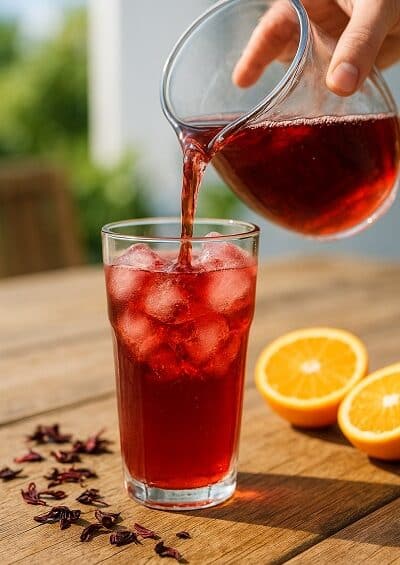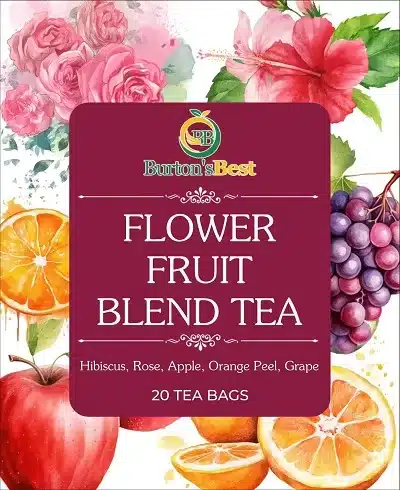If you’ve ever had iced hibiscus tea at a café and thought, “Why doesn’t it taste this good when I make it at home?” — don’t worry, you’re not alone. Hibiscus is one of those teas that can either be incredible… or kind of flat and sour if it’s brewed wrong.
The secret isn’t complicated but it is specific. I learned this when I started experimenting with making herbal teas taste as good iced as they do hot. Hibiscus has such a bold, tart, cranberry-like flavor that, when handled right, tastes refreshing, floral, and bright. When handled wrong? It tastes like someone dissolved a sour cherry cough drop in water.
So today, we’ll do it barista style, but simple. No syrup bottles, no specialty gear, no complicated steps. Just the right ratios, steeping method, and cooling technique.
Why Hibiscus Works So Well Iced
Hibiscus is naturally:
Caffeine-free (great for afternoons and evenings)
High in antioxidants
Bright and refreshing instead of heavy
Beautifully red (seriously — it looks like summer in a glass)
It’s the kind of drink that feels healthy while still hitting the spot like juice or lemonade.
But to get that café-quality flavor, you have to brew it stronger than you think.
The Barista Rule: Brew Strong → Dilute Cold
If you make hibiscus tea the same strength as you would to drink it hot, the flavors get washed out when you add ice. That’s why iced café tea always tastes bolder, they brew it concentrated on purpose.
So the rule is:
For iced hibiscus tea, use 2x the tea you’d use for hot tea.
If your tea normally calls for:
1 tsp per cup → use 2 tsp
1 tea bag per cup → use 2 tea bags
Or, easiest:
¼ cup dried hibiscus flowers per quart of water
Step-by-Step: Iced Hibiscus Tea (The Right Way)
You’ll Need:
4 cups water (filtered if possible)
4 hibiscus tea bags (or ¼ cup dried hibiscus)
1–3 tablespoons honey (or agave) added while warm
A slice of orange or lime (optional, but recommended)
1. Heat Your Water (But Don’t Boil It Hard)
Bring your water just to a gentle simmer, not a rolling boil.
Boiling too hard makes hibiscus taste sharper and more sour.
Ideal water temperature: 190–200°F
Close enough: steaming but not aggressively bubbling.
2. Add the Hibiscus and Steep Longer Than Hot Tea
Steep 10–15 minutes.
Hibiscus needs a little extra time to fully bloom and release flavor.
Go too short → weak and thin.
Go too long → overly tart.
10–15 minutes is the sweet spot.
3. Sweeten While Warm (Not Cold)
Honey or agave dissolves better in warm tea — and you’ll use less to get the same flavor impact.
Start with 1 tablespoon, taste, then adjust.
(If you’re avoiding added sugar, hibiscus is delicious unsweetened, bright and tangy.)
4. Chill Completely Before Pouring Over Ice
If you pour hot tea over ice, it waters down instantly.
Let it cool in the fridge at least 1 hour , or make it at night for tomorrow.
5. Serve Over Ice + Citrus
This is the secret move:
Add a slice of orange or lime right into the glass.
The citrus lifts the flavor and balances the tang.
Bonus: Make It Café-Gourmet With One Add-In
Choose one, depending on the vibe:
| Add-In | Flavor Result | When to Use |
|---|---|---|
| Fresh Mint Sprig | Cooling + refreshing | Hot days |
| Cinnamon Stick (steeped) | Warm + deeper flavor | Fall evenings |
| Ginger Slice (steeped) | Crisp + spicy | Morning or workout drink |
Final Tip: Batch Brew and Keep in Your Fridge
Iced hibiscus tea stays great for up to 4 days in the refrigerator.
Make a pitcher, keep it ready, and you’ll reach for it instead of soda or juice.
And if you’re trying to replace coffee or cut caffeine, hibiscus is one of the easiest, most enjoyable swaps — no sacrifice required.


